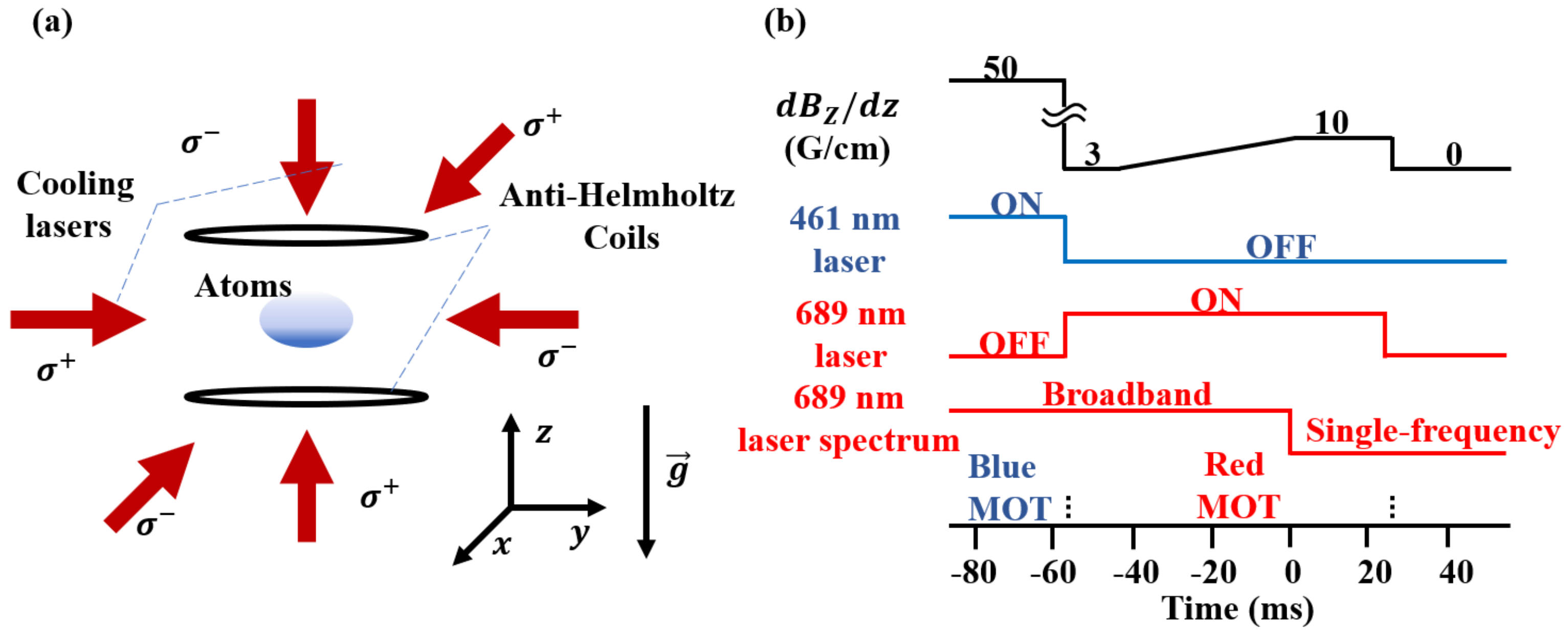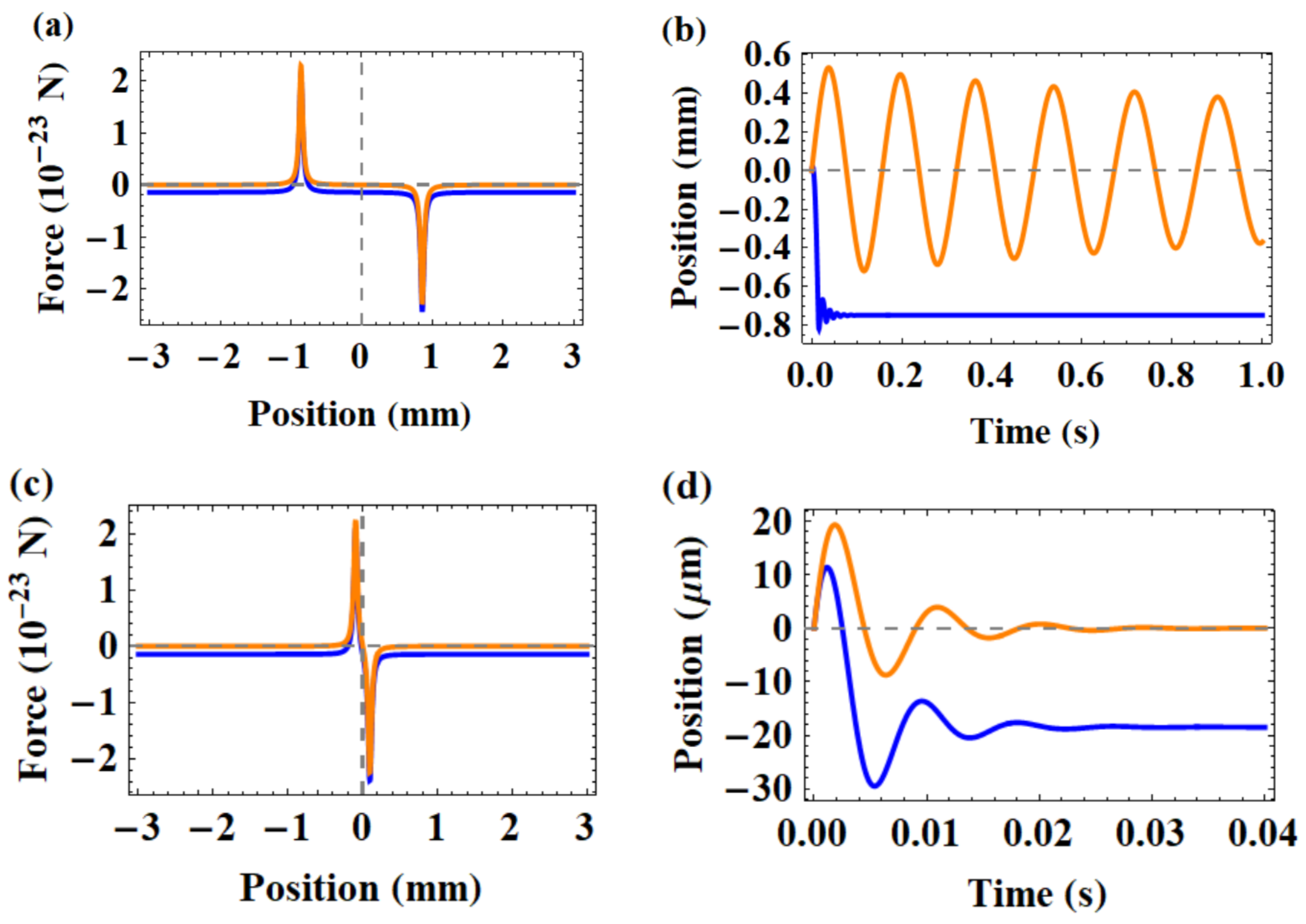Analysis of Narrow-Line Laser Cooling and Trapping of Sr Atoms in Microgravity Environments
Abstract
:1. Introduction
2. Simulation of Behaviors of a Single Atom Driven by Mean Force
3. Monte Carlo Simulation of Behaviors of Ensemble Atoms Associated with Spontaneous Emission
4. A Proposal of Designing the MOTs Based on Narrow-Line Transitions in Microgravity Environments
5. Conclusions
Author Contributions
Funding
Conflicts of Interest
References
- Elliott, E.R.; Krutzik, M.C.; Williams, J.R.; Thompson, R.J.; Aveline, D.C. NASA’s Cold Atom Lab (CAL): System development and ground test status. NPJ Microgravity 2018, 4, 16. [Google Scholar] [CrossRef] [PubMed]
- Lezius, M.; Wilken, T.; Deutsch, C.; Giunta, M.; Mandel, O.; Thaller, A.; Schkolnik, V.; Schiemangk, M.; Dinkelaker, A.; Kohfeldt, A.; et al. Space-borne frequency comb metrology. Optica 2016, 3, 1381. [Google Scholar] [CrossRef]
- Graham, P.W.; Hogan, J.M.; Kasevich, M.A.; Rajendran, S. New Method for Gravitational Wave Detection with Atomic Sensors. Phys. Rev. Lett. 2013, 110, 171102. [Google Scholar] [CrossRef] [Green Version]
- Savalle, E.; Guerlin, C.; Delva, P.; Meynadier, F.; le Poncin-Lafitte, C.; Wolf, P. Gravitational redshift test with the future ACES mission. Class. Quantum Gravity 2019, 36, 245004. [Google Scholar] [CrossRef] [Green Version]
- Reynaud, S.; Salomon, C.; Wolf, P. Testing General Relativity with Atomic Clocks. Space Sci. Rev. 2009, 148, 233–247. [Google Scholar] [CrossRef] [Green Version]
- Lämmerzahl, C.; Ahlers, G.; Ashby, N.; Barmatz, M.; Biermann, P.L.; Dittus, H.; Dohm, V.; Duncan, R.; Gibble, K.; Lipa, J.; et al. Review: Experiments in Fundamental Physics Scheduled and in Development for the ISS. Gen. Relat. Gravit. 2004, 36, 615–649. [Google Scholar] [CrossRef]
- Liu, L.; Lü, D.S.; Chen, W.B.; Li, T.; Qu, Q.Z.; Wang, B.; Li, L.; Ren, W.; Dong, Z.R.; Zhao, J.B.; et al. In-orbit operation of an atomic clock based on laser-cooled 87Rb atoms. Nat. Commun. 2018, 9, 2760. [Google Scholar] [CrossRef] [Green Version]
- Laurent, P.; Lemonde, P.; Simon, E.; Santarelli, G.; Clairon, A.; Dimarcq, N.; Petit, P.; Audoin, C.; Salomon, C. A cold atom clock in absence of gravity. Eur. Phys. J. D 1998, 3, 201–204. [Google Scholar] [CrossRef]
- Abgrall, M.; Chupin, B.; De Sarlo, L.; Guéna, J.; Laurent, P.; Le Coq, Y.; Le Targat, R.; Lodewyck, J.; Lours, M.; Rosenbusch, P.; et al. Atomic fountains and optical clocks at SYRTE: Status and perspectives. C. R. Phys. 2015, 16, 461–470. [Google Scholar] [CrossRef] [Green Version]
- Schiller, S.; Görlitz, A.; Nevsky, A.; Koelemeij, J.; Wicht, A.; Gill, P.; Klein, H.; Margolis, H.; Mileti, G.; Sterr, U.; et al. Optical Clocks in Space. Nucl. Phys. B Proc. Suppl. 2007, 166, 300–302. [Google Scholar] [CrossRef]
- Bongs, K.; Singh, Y.; Smith, L.; He, W.; Kock, O.; Świerad, D.; Hughes, J.; Schiller, S.; Alighanbari, S.; Origlia, S.; et al. Development of a strontium optical lattice clock for the SOC mission on the ISS. C. R. Phys. 2015, 16, 553–564. [Google Scholar] [CrossRef]
- Becker, D.; Lachmann, M.D.; Seidel, S.T.; Ahlers, H.; Dinkelaker, A.N.; Grosse, J.; Hellmig, O.; Müntinga, H.; Schkolnik, V.; Wendrich, T.; et al. Space-borne Bose–Einstein condensation for precision interferometry. Nature 2018, 562, 391–395. [Google Scholar] [CrossRef] [PubMed]
- van Zoest, T.; Gaaloul, N.; Singh, Y.; Ahlers, H.; Herr, W.; Seidel, S.T.; Ertmer, W.; Rasel, E.; Eckart, M.; Kajari, E.; et al. Bose-Einstein Condensation in Microgravity. Science 2010, 328, 1540–1543. [Google Scholar] [CrossRef] [PubMed] [Green Version]
- Stern, G.; Battelier, B.; Geiger, R.; Varoquaux, G.; Villing, A.; Moron, F.; Carraz, O.; Zahzam, N.; Bidel, Y.; Chaibi, W.; et al. Light-pulse atom interferometry in microgravity. Eur. Phys. J. D 2009, 53, 353–357. [Google Scholar] [CrossRef] [Green Version]
- Barrett, B.; Antoni-Micollier, L.; Chichet, L.; Battelier, B.; Lévèque, T.; Landragin, A.; Bouyer, P. Dual matter-wave inertial sensors in weightlessness. Nat. Commun. 2016, 7, 13786. [Google Scholar] [CrossRef]
- Ruhmann, S.; Riedmann, M.; Wubbena, T.; Kulosa, A.; Pape, A.; Fim, D.; Zipfel, K.; Lampmann, B.; Friebe, J.; Kelkar, H.; et al. Towards a magnesium optical lattice clock. In 2011 Conference on Lasers and Electro-Optics Europe and 12th European Quantum Electronics Conference (CLEO EUROPE/EQEC); Optical Society of America: Washington, DC, USA, 2011; p. EC_P2. [Google Scholar] [CrossRef]
- Degenhardt, C.; Stoehr, H.; Lisdat, C.; Wilpers, G.; Schnatz, H.; Lipphardt, B.; Nazarova, T.; Pottie, P.E.; Sterr, U.; Helmcke, J.; et al. Calcium optical frequency standard with ultracold atoms: Approaching 10–15 relative uncertainty. Phys. Rev. A Atom. Mol. Opt. Phys. 2005, 72, 1–17. [Google Scholar] [CrossRef] [Green Version]
- Bothwell, T.; Kedar, D.; Oelker, E.; Robinson, J.M.; Bromley, S.L.; Tew, W.L.; Ye, J.; Kennedy, C.J. JILA SrI optical lattice clock with uncertainty of 2.0 × 10−18. Metrologia 2019, 56, 065004. [Google Scholar] [CrossRef] [Green Version]
- Wang, Y.B.; Yin, M.J.; Ren, J.; Xu, Q.F.; Lu, B.Q.; Han, J.X.; Guo, Y.; Chang, H. Strontium optical lattice clock at the National Time Service Center. Chin. Phys. B 2018, 27, 023701. [Google Scholar] [CrossRef]
- Hinkley, N.; Sherman, A.; Phillips, N.B.; Schioppo, M.; Lemke, N.D.; Beloy, K.; Pizzocaro, M.; Oates, C.W.; Ludlow, A.D. An atomic clock with 10–18 instability. Science 2013, 341, 1215–1218. [Google Scholar] [CrossRef] [Green Version]
- Tyumenev, R.; Favier, M.; Bilicki, S.; Bookjans, E.; Targat, R.L.; Lodewyck, J.; Nicolodi, D.; Coq, Y.L.; Abgrall, M.; Guéna, J.; et al. Comparing a mercury optical lattice clock with microwave and optical frequency standards. New J. Phys. 2016, 18, 113002. [Google Scholar] [CrossRef]
- Kraft, S.; Vogt, F.; Appel, O.; Riehle, F.; Sterr, U. Bose-Einstein Condensation of Alkaline Earth Atoms: 40Ca. Phys. Rev. Lett. 2009, 103, 130401. [Google Scholar] [CrossRef] [PubMed] [Green Version]
- de Escobar, Y.N.M.; Mickelson, P.G.; Yan, M.; DeSalvo, B.J.; Nagel, S.B.; Killian, T.C. Bose-Einstein Condensation of 84Sr. Phys. Rev. Lett. 2009, 103, 200402. [Google Scholar] [CrossRef] [PubMed] [Green Version]
- Stellmer, S.; Tey, M.K.; Huang, B.; Grimm, R.; Schreck, F. Bose-Einstein Condensation of Strontium. Phys. Rev. Lett. 2009, 103, 200401. [Google Scholar] [CrossRef] [PubMed] [Green Version]
- Vogel, K.; Dinneen, T.; Gallagher, A.; Hall, J. Narrow-line Doppler cooling of strontium to the recoil limit. IEEE Trans. Instrum. Meas. 1999, 48, 618–621. [Google Scholar] [CrossRef]
- Binnewies, T.; Wilpers, G.; Sterr, U.; Riehle, F.; Helmcke, J.; Mehlstäubler, T.E.; Rasel, E.M.; Ertmer, W. Doppler Cooling and Trapping on Forbidden Transitions. Phys. Rev. Lett. 2001, 87, 123002. [Google Scholar] [CrossRef] [Green Version]
- Ushijima, I.; Takamoto, M.; Das, M.; Ohkubo, T.; Katori, H. Cryogenic optical lattice clocks. Nat. Photonics 2015, 9, 185–189. [Google Scholar] [CrossRef]
- Campbell, S.L.; Hutson, R.B.; Marti, G.E.; Goban, A.; Darkwah Oppong, N.; McNally, R.L.; Sonderhouse, L.; Robinson, J.M.; Zhang, W.; Bloom, B.J.; et al. A Fermi-degenerate three-dimensional optical lattice clock. Science 2017, 358, 90–94. [Google Scholar] [CrossRef] [Green Version]
- Tino, G.M.; Bassi, A.; Bianco, G.; Bongs, K.; Bouyer, P.; Cacciapuoti, L.; Capozziello, S.; Chen, X.; Chiofalo, M.L.; Derevianko, A.; et al. SAGE: A proposal for a space atomic gravity explorer. Eur. Phys. J. D 2019, 73, 228. [Google Scholar] [CrossRef]
- Loriani, S.; Schlippert, D.; Schubert, C.; Abend, S.; Ahlers, H.; Ertmer, W.; Rudolph, J.; Hogan, J.M.; Kasevich, M.A.; Rasel, E.M.; et al. Atomic source selection in space-borne gravitational wave detection. New J. Phys. 2019, 21, 063030. [Google Scholar] [CrossRef] [Green Version]
- Loftus, T.H.; Ido, T.; Boyd, M.M.; Ludlow, A.D.; Ye, J. Narrow line cooling and momentum-space crystals. Phys. Rev. A 2004, 70, 1–14. [Google Scholar] [CrossRef] [Green Version]
- Loftus, T.H.; Ido, T.; Ludlow, A.D.; Boyd, M.M.; Ye, J. Narrow Line Cooling: Finite Photon Recoil Dynamics. Phys. Rev. Lett. 2004, 93, 073003. [Google Scholar] [CrossRef] [PubMed] [Green Version]
- Mukaiyama, T.; Katori, H.; Ido, T.; Li, Y.; Kuwata-Gonokami, M. Recoil-Limited Laser Cooling of 87Sr Atoms near the Fermi Temperature. Phys. Rev. Lett. 2003, 90, 4. [Google Scholar] [CrossRef] [PubMed]
- Katori, H.; Ido, T.; Isoya, Y.; Kuwata-Gonokami, M. Magneto-optical trapping and cooling of strontium atoms down to the photon recoil temperature. Phys. Rev. Lett. 1999, 82, 1116–1119. [Google Scholar] [CrossRef]
- Wang, Y.; Lu, X.; Lu, B.; Kong, D.; Chang, H. Recent Advances Concerning the 87Sr Optical Lattice Clock at the National Time Service Center. Appl. Sci. 2018, 8, 2194. [Google Scholar] [CrossRef] [Green Version]
- Lu, X.; Yin, M.; Li, T.; Wang, Y.; Chang, H. An Evaluation of the Zeeman Shift of the 87Sr Optical Lattice Clock at the National Time Service Center. Appl. Sci. 2020, 10, 1440. [Google Scholar] [CrossRef] [Green Version]




© 2020 by the authors. Licensee MDPI, Basel, Switzerland. This article is an open access article distributed under the terms and conditions of the Creative Commons Attribution (CC BY) license (http://creativecommons.org/licenses/by/4.0/).
Share and Cite
Ren, J.; Liu, H.; Lu, X.; Chang, H. Analysis of Narrow-Line Laser Cooling and Trapping of Sr Atoms in Microgravity Environments. Appl. Sci. 2020, 10, 4928. https://doi.org/10.3390/app10144928
Ren J, Liu H, Lu X, Chang H. Analysis of Narrow-Line Laser Cooling and Trapping of Sr Atoms in Microgravity Environments. Applied Sciences. 2020; 10(14):4928. https://doi.org/10.3390/app10144928
Chicago/Turabian StyleRen, Jie, Hui Liu, Xiaotong Lu, and Hong Chang. 2020. "Analysis of Narrow-Line Laser Cooling and Trapping of Sr Atoms in Microgravity Environments" Applied Sciences 10, no. 14: 4928. https://doi.org/10.3390/app10144928
APA StyleRen, J., Liu, H., Lu, X., & Chang, H. (2020). Analysis of Narrow-Line Laser Cooling and Trapping of Sr Atoms in Microgravity Environments. Applied Sciences, 10(14), 4928. https://doi.org/10.3390/app10144928




